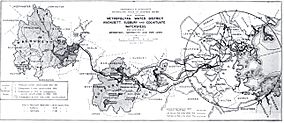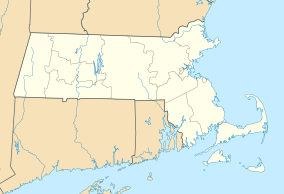Sudbury Reservoir facts for kids
Quick facts for kids Sudbury Reservoir |
|
|---|---|

Metropolitan Water District system, 1910
|
|
| Location | Middlesex County and Worcester County, Massachusetts, United States |
| Area | 4,943 acres (20.00 km2) |
| Elevation | 249 ft (76 m) |
| Established | 1894-1898 |
| Governing body | Massachusetts Department of Conservation and Recreation |
| Website | Sudbury Reservoir |
The Sudbury Reservoir is an important backup water supply for the Boston area in Massachusetts. It covers about 2.02 square miles (5.2 square kilometers). Most of the reservoir is located in Southborough and Marlborough. Smaller parts are in Westborough and Framingham.
The reservoir was made when the Sudbury Dam was built. This dam holds back water from the Stony Brook branch of the Sudbury River. Even though it's called Sudbury Reservoir, it's not actually in the town of Sudbury. Almost 5,000 acres (2,023 hectares) around the reservoir are managed by the Massachusetts Department of Conservation and Recreation. This area is a public recreation spot with some rules about how you can use it.
Contents
How the Sudbury Reservoir Was Built
Work on the Sudbury Reservoir system started in 1878. It was part of a bigger plan to collect water from the Sudbury River. This water was meant to add to the supply from the Lake Cochituate system near Natick.
The main part of the reservoir we see today was dug out between 1894 and 1898. The construction happened in different stages. The City of Boston began the project. However, the newly formed Metropolitan Water Board finished it. This board later became the Massachusetts Water Resources Authority. Building the reservoir involved moving a huge amount of soil and rocks. Workers moved about 4.5 million cubic yards (3.4 million cubic meters) of material.
Water began to fill the reservoir on February 8, 1897. The new Sudbury Dam on the Stony Brook branch of the Sudbury River was completed later that same year.
How the Reservoir Works
When the Sudbury Reservoir was finished, its surface area was about 2.02 square miles (5.2 square kilometers). Its average depth was 17 feet (5.2 meters), and its deepest point was 65 feet (20 meters). The reservoir could hold about 7.253 billion US gallons (27.45 billion liters) of water.
Water flowed into the Sudbury Reservoir from the Wachusett Reservoir to the west. This water came through the Wachusett Aqueduct, built in 1898. Local streams also fed the reservoir. To keep the stream water clean, special filter beds were built next to the reservoir.
The reservoir's water was then sent to the Weston Reservoir to the east. This happened through the Weston Aqueduct, completed in 1901. Water could also go through a channel to the Framingham reservoirs. From there, it traveled through the Sudbury Aqueduct to the Chestnut Hill Reservoir.
Sudbury Reservoir Today
Over time, some older reservoirs in the system became state parks. These included Whitehall, Hopkinton, Ashland, and Cochituate. This change happened in 1947.
In 1976, the entire Sudbury System was officially changed. It became an emergency water supply. Today, only the Sudbury Reservoir and the Foss Reservoir (Framingham Reservoir No. 3) are still used as backup drinking water sources. The Weston and Sudbury aqueducts are also kept as backup ways to move water.
In an emergency, the Sudbury and Foss reservoirs can be used in a few ways. They can be a main water source. They can also be a way to move water from the Quabbin or Wachusett reservoirs if the usual paths are blocked. Or, they can provide extra water during a major drought. If this water is used, it would not be treated. People would likely need to boil it before drinking.
Fun Things to Do at the Reservoir
The Sudbury Reservoir area has some public access, but it is limited. You can enjoy activities like picnicking and hiking. In winter, you can go snowshoeing or cross-country skiing. Fishing from the shoreline is also allowed, but there are some rules.
Images for kids





